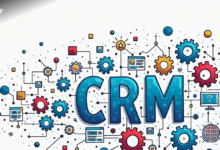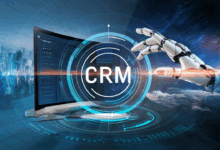CRM For Sales And Marketing Automation: Streamlining Business Processes
CRM for Sales and Marketing Automation revolutionizes how businesses manage customer relationships and automate sales and marketing tasks, paving the way for increased efficiency and productivity. Dive into the world of CRM systems and discover the key features that drive success in today’s competitive market.
Introduction to CRM for Sales and Marketing Automation
CRM (Customer Relationship Management) software plays a crucial role in facilitating sales and marketing automation for businesses. These tools help companies organize customer data, track interactions, and manage leads effectively, leading to improved customer relationships and increased sales opportunities.
Key Features of CRM Systems
- Centralized Customer Database: CRM systems provide a centralized database where businesses can store and access all customer information, including contact details, purchase history, and communication logs.
- Lead Management: CRM tools assist in managing leads by tracking their progress through the sales pipeline, assigning tasks, and setting reminders for follow-ups.
- Interaction Tracking: CRM software enables businesses to monitor customer interactions across various channels, such as emails, phone calls, and social media, allowing for personalized communication.
- Reporting and Analytics: CRM systems offer reporting and analytics features that provide insights into sales performance, customer behavior, and marketing campaigns, helping businesses make data-driven decisions.
Importance of CRM Integration with Marketing Automation
Integrating CRM tools with marketing automation platforms enhances workflow efficiency by aligning sales and marketing efforts, improving lead nurturing, and enabling targeted campaigns based on customer data.
Popular CRM Software Options
| CRM Software | Features |
|---|---|
| Salesforce | Customizable dashboards, lead management, email integration |
| HubSpot CRM | Marketing automation, contact management, reporting tools |
| Zoho CRM | Sales forecasting, workflow automation, social media integration |
Implementation Process and Best Practices
- Define Goals and Objectives: Clearly outline what you aim to achieve with CRM implementation, whether it’s improved customer retention, increased sales, or better lead management.
- Train Your Team: Provide comprehensive training to employees on how to use the CRM system effectively to maximize its benefits.
- Customize and Configure: Tailor the CRM software to meet your specific business needs by customizing fields, workflows, and reports.
- Regularly Update and Maintain: Keep the CRM system updated with accurate data and perform regular maintenance to ensure smooth operation.
Key Features of CRM Software
CRM software plays a crucial role in sales and marketing automation by providing essential features that streamline processes and improve customer engagement. Let’s explore some key features that enhance lead management and customer interactions.
Lead Management and Customer Engagement
- Lead scoring: CRM tools allow businesses to assign scores to leads based on their interactions and behavior, helping prioritize high-quality leads.
- Automated lead nurturing: Automation capabilities in CRM software enable personalized and timely communication with leads, increasing the chances of conversion.
- Contact management: CRM systems centralize customer data, making it easier to track interactions and provide a seamless customer experience.
Data Analytics for Personalized Interactions
- Advanced reporting: CRM software provides insights into customer behavior and trends, allowing businesses to create personalized marketing campaigns.
- Predictive analytics: By analyzing data, CRM tools can predict customer needs and preferences, leading to more targeted and effective marketing strategies.
Integration and Efficiency
- Third-party integrations: CRM systems can integrate with other tools and platforms, such as email marketing software or social media platforms, streamlining processes and improving efficiency.
Cloud-Based vs. On-Premise Solutions
- Scalability: Cloud-based CRM solutions offer scalability, allowing businesses to easily adjust resources based on their needs, while on-premise options may require additional hardware upgrades.
- Accessibility: Cloud-based CRM software provides remote access from anywhere with an internet connection, offering greater flexibility compared to on-premise solutions.
Implementation of CRM Systems
Implementing a CRM system for sales and marketing automation is a crucial step for organizations looking to streamline their processes and improve customer relationships. It involves several key steps and considerations to ensure successful deployment and adoption.
Steps Involved in Implementing a CRM System
- Assessing business needs and objectives: Before choosing a CRM software, organizations must first identify their specific goals and requirements.
- Choosing the right CRM solution: Select a CRM system that aligns with the organization’s needs, budget, and scalability.
- Customizing the CRM platform: Tailor the CRM software to fit the organization’s unique processes and workflows.
- Training and onboarding: Provide comprehensive training to employees to ensure they fully understand how to use the CRM system effectively.
- Data migration: Transfer existing customer data to the new CRM platform accurately and securely.
- Testing and optimization: Conduct thorough testing to identify and resolve any issues before full implementation.
- Continuous monitoring and improvement: Regularly review CRM performance and make necessary adjustments to optimize its functionality.
Challenges Organizations May Face During CRM Implementation
- Resistance to change: Employees may be reluctant to adopt new technology or processes, leading to implementation challenges.
- Data quality issues: Inaccurate or incomplete data can hinder the effectiveness of the CRM system and impact decision-making.
- Lack of executive buy-in: Without support from top management, CRM implementation may face obstacles and delays.
- Integration complexities: Integrating the CRM system with existing applications and systems can be complex and time-consuming.
Best Practices for Successful CRM Deployment and Adoption
- Secure executive sponsorship: Ensure that senior leaders are actively involved in and supportive of the CRM implementation process.
- Engage end-users early: Involve employees in the decision-making process and provide training to increase user adoption rates.
- Focus on data quality: Regularly clean and update customer data to maintain the accuracy and reliability of the CRM system.
- Monitor performance metrics: Track key performance indicators to measure the effectiveness of the CRM system and make data-driven decisions.
- Provide ongoing support: Offer continuous training and support to employees to enhance their CRM skills and maximize system utilization.
Integration with Marketing Automation Platforms
Integrating CRM with marketing automation platforms is crucial for enhancing customer segmentation and personalizing marketing efforts.
API Integration
- API integration allows seamless communication between CRM and marketing automation tools, improving lead generation and conversion rates.
- Setting up API integration involves creating connections between the two systems to enable data synchronization for efficient workflows.
- API integration ensures real-time data transfer, enabling targeted email campaigns, lead scoring, and performance tracking.
Middleware Tools Integration
- Middleware tools act as connectors between CRM and marketing automation platforms, facilitating smooth data exchange.
- These tools streamline the integration process, reducing manual efforts and enhancing automation capabilities.
- Middleware integration allows for better data mapping and synchronization, leading to improved marketing strategies and customer engagement.
Direct Integration
- Direct integration involves linking CRM and marketing automation platforms without intermediary tools, enabling a direct data flow between the systems.
- This method ensures a seamless connection, minimizing data discrepancies and improving overall marketing performance.
- Direct integration enhances lead nurturing, personalized campaigns, and accurate data tracking for better decision-making.
Automated Workflows Setup
Setting up automated workflows between CRM and marketing automation tools involves:
- Identifying key data points for synchronization.
- Mapping fields between CRM and marketing automation systems for accurate data transfer.
- Configuring triggers and actions for automated processes such as lead scoring, email campaigns, and performance tracking.
Role of Data Mapping
- Data mapping ensures the accurate transfer of information between CRM and marketing automation platforms, maintaining data integrity and consistency.
- Mapping fields and attributes help in aligning customer data for targeted marketing campaigns and personalized communication.
- Effective data mapping leads to improved segmentation, better lead management, and enhanced customer experiences.
Benefits of Integration
- Targeted Email Campaigns: Integration allows for personalized email campaigns based on customer data and behavior.
- Lead Scoring: Automated workflows enable lead scoring to identify high-potential leads for sales engagement.
- Performance Tracking: Integration provides insights into campaign performance, lead conversions, and ROI for continuous improvement.
Data Management and Analytics in CRM
Data management and analytics play a crucial role in CRM for sales and marketing automation. By effectively collecting, organizing, and analyzing customer data, CRM systems enable businesses to make informed decisions and personalize their marketing strategies.
Role of Data Management in CRM
Data management in CRM involves the collection, storage, and maintenance of customer information such as contact details, purchase history, preferences, and interactions. This data is essential for understanding customer behavior, identifying trends, and segmenting customers based on their characteristics.
- Ensures data accuracy and consistency
- Facilitates targeted marketing campaigns
- Improves customer service and relationship management
Analyzing Customer Data in CRM
CRM systems use advanced analytics tools to process large volumes of data and extract valuable insights. By analyzing customer data, businesses can identify patterns, predict future behavior, and optimize their sales and marketing efforts.
- Identifying cross-selling and upselling opportunities
- Measuring the effectiveness of marketing campaigns
- Forecasting sales trends and pipeline performance
Examples of Data Analytics Tools
There are several data analytics tools that are commonly used in conjunction with CRM software to enhance data management and analysis capabilities. Some popular examples include:
| 1. Salesforce Einstein Analytics | Utilizes AI and machine learning to deliver predictive insights |
| 2. Microsoft Power BI | Offers interactive visualizations and real-time dashboards |
| 3. Tableau | Enables users to create interactive data visualizations and reports |
Personalization and Customer Segmentation
Personalization and customer segmentation play a crucial role in CRM for sales and marketing automation. By tailoring marketing campaigns to specific customer segments and personalizing interactions, businesses can enhance customer engagement and drive sales.
Significance of Personalization
Personalization in CRM allows businesses to create targeted and relevant marketing messages for individual customers. This level of customization helps in building stronger relationships with customers, increasing brand loyalty, and ultimately improving customer retention rates.
Customer Segmentation Strategies
- Utilize CRM data to categorize customers based on demographics, behavior, purchase history, and preferences.
- Segment customers into groups to deliver personalized content, offers, and recommendations that resonate with their needs and interests.
- Implement dynamic segmentation to adjust customer groups in real-time based on changing behaviors and interactions.
Leveraging CRM Data for Personalization
- Collect and analyze customer data from various touchpoints to gain insights into individual preferences and behaviors.
- Use data-driven decision-making to create personalized customer experiences that drive engagement and conversions.
- Automate personalized interactions through CRM systems to deliver timely and relevant messages across multiple channels.
Lead Generation and Nurturing
Lead generation and nurturing are crucial processes within CRM systems that help businesses identify potential customers, capture their interest, and guide them towards making a purchase. CRM software plays a vital role in streamlining these processes by providing tools and functionalities to manage leads effectively.
Lead Scoring for Prioritization
Lead scoring is a key feature in CRM software that assigns values to leads based on their behavior, demographics, and interactions with the company. This helps in prioritizing leads for nurturing efforts, ensuring that sales and marketing teams focus on the most promising leads first.
- Lead scoring allows businesses to prioritize leads based on their readiness to make a purchase, helping in efficient allocation of resources.
- By assigning scores to leads, CRM systems ensure that sales teams can focus on high-value leads that are more likely to convert into customers.
- Automated lead scoring in CRM software saves time and eliminates manual processes, enabling teams to act on leads promptly.
Automated Workflows for Streamlining Processes
CRM software enables the creation of automated workflows that guide leads through the nurturing process based on predefined criteria and actions. These workflows help in maintaining consistency and efficiency in lead nurturing efforts.
- Automated workflows in CRM systems ensure that leads receive relevant and timely communication, increasing the chances of conversion.
- By automating repetitive tasks such as sending follow-up emails or reminders, CRM software frees up time for sales and marketing teams to focus on building relationships with leads.
- Tracking lead interactions through automated workflows provides valuable insights for optimizing the nurturing process and improving conversion rates.
Inbound vs. Outbound Lead Generation Techniques
Inbound lead generation focuses on attracting leads through valuable content and personalized experiences, while outbound lead generation involves reaching out to potential customers through cold calling, emails, or advertising. CRM systems play a crucial role in implementing both strategies effectively.
- Inbound lead generation leverages content marketing, SEO, and social media to attract leads who are actively seeking solutions, resulting in higher quality leads.
- Outbound lead generation involves reaching out to a broader audience to generate interest, with CRM software helping in tracking and managing these outbound efforts efficiently.
- CRM platforms enable personalized content creation and targeted campaigns that resonate with leads, increasing engagement and nurturing relationships effectively.
Workflow Automation and Customization
Workflow automation plays a crucial role in CRM systems for streamlining sales and marketing processes. By automating repetitive tasks and standardizing procedures, workflow automation enhances operational efficiency and ensures consistency in customer interactions.
The Role of Workflow Automation
- Automated workflows help in reducing manual effort and errors in data entry, lead assignment, and follow-up activities.
- They ensure timely notifications and reminders for sales reps, improving response times and customer engagement.
- Workflow automation enables real-time tracking of sales activities and performance metrics, facilitating data-driven decision-making.
Customizable Workflows for Operational Efficiency
- Customizable workflows in CRM systems allow businesses to tailor processes according to their specific requirements and objectives.
- By adapting workflows to unique sales and marketing strategies, organizations can optimize resource allocation and boost productivity.
- Customization enables the integration of multiple communication channels and personalized customer interactions, enhancing overall customer experience.
Designing Automated Workflows
- Identify key sales and marketing activities that can be automated, such as lead qualification, email campaigns, and task assignments.
- Create a visual flowchart of the workflow with defined triggers, conditions, and actions for each step.
- Collaborate with sales, marketing, and IT teams to ensure the seamless implementation and alignment of automated workflows.
Setting Up Automated Triggers in CRM
- Define specific events or conditions that will trigger automated actions, such as lead scoring thresholds, email opens, or website visits.
- Configure rules for automatic notifications, task assignments, and follow-up sequences based on trigger criteria.
- Regularly monitor and adjust trigger settings to optimize workflow performance and response rates.
Tracking KPIs Through Automated Workflows
- Key performance indicators (KPIs) that can be tracked through automated workflows include lead conversion rates, customer acquisition costs, and sales cycle length.
- Automated reporting and analytics tools provide real-time insights into KPIs, enabling proactive decision-making and performance evaluation.
- Continuous monitoring of KPIs helps in identifying trends, gaps, and opportunities for improvement in sales and marketing strategies.
Integrating AI and Machine Learning Algorithms
- Integrating AI and machine learning algorithms into automated workflows can enhance predictive analytics, lead scoring, and personalized content recommendations.
- AI-driven insights enable dynamic adjustments to workflows based on customer behavior, preferences, and engagement patterns.
- Machine learning algorithms optimize workflow performance by analyzing historical data, predicting outcomes, and automating decision-making processes.
Testing and Refining Automated Workflows
- Testing automated workflows involves validating trigger conditions, action sequences, and data integration points to ensure accuracy and reliability.
- Regularly review performance metrics, user feedback, and system logs to identify bottlenecks, errors, or inefficiencies in automated workflows.
- Iteratively refine workflows based on feedback, performance data, and industry best practices to continually enhance operational efficiency and customer satisfaction.
Mobile CRM Applications
Mobile CRM applications have revolutionized the way sales and marketing teams operate, providing flexibility and efficiency in managing customer relationships on the go. These tools enable real-time access to vital data, enhance collaboration, and improve productivity for businesses of all sizes.
Benefits of Mobile CRM Applications
- Increased accessibility to customer information
- Enhanced communication and collaboration among team members
- Improved efficiency in managing sales activities
- Streamlined workflows and faster decision-making processes
Comparison of Popular Mobile CRM Applications
| CRM Tool | Pricing | Integration Options | Customer Support |
|---|---|---|---|
| Salesforce Mobile | Varies based on plan | Extensive integrations with third-party apps | 24/7 customer support |
| Zoho CRM Mobile | Free for up to 3 users | Integrates with Zoho suite of products | Online support during business hours |
| HubSpot Mobile | Included in HubSpot CRM subscription | Seamless integration with HubSpot tools | Email and chat support |
Setting Up a Mobile CRM System for Sales Teams
- Choose the right mobile CRM application based on your business needs
- Customize the app to align with your sales processes and data requirements
- Migrate existing data to the mobile CRM system for seamless transition
- Train your sales team on using the mobile CRM effectively for maximum impact
Case Study: Improved Sales Performance with Mobile CRM
Company XYZ implemented Salesforce Mobile for their sales team, resulting in a 20% increase in lead conversion rates and a 15% boost in overall sales revenue within the first quarter of usage.
Customer Relationship Management Strategies
In today’s competitive business landscape, effective CRM strategies play a crucial role in building and maintaining customer relationships. By leveraging CRM tools, companies can enhance customer engagement, improve retention rates, and drive sales and marketing efforts to success.
Importance of Customer Engagement and Retention
Customer engagement and retention are vital components of any successful sales and marketing strategy. Engaged customers are more likely to make repeat purchases, refer others to the business, and remain loyal over time. By focusing on building strong relationships with customers, businesses can drive revenue growth and establish a positive brand reputation.
Tips for Developing Personalized Communication Strategies
- Utilize customer data: Leverage CRM software to gather information about customer preferences, behaviors, and past interactions. Use this data to tailor communication strategies and offer personalized experiences.
- Segment your audience: Divide customers into specific groups based on demographics, buying patterns, or engagement levels. Create targeted campaigns and messages that resonate with each segment.
- Automate personalized interactions: Implement automated workflows in your CRM system to send personalized messages at the right time. This can help nurture leads, drive conversions, and improve overall customer satisfaction.
- Monitor and analyze results: Track the performance of your communication strategies using CRM analytics. Measure key metrics such as open rates, click-through rates, and conversion rates to optimize future campaigns.
Integration with E-commerce Platforms
CRM integration with e-commerce platforms plays a crucial role in enhancing sales and marketing automation by providing a seamless connection between customer data and online retail processes.
Enhanced Customer Interactions and Sales Processes
By integrating CRM systems with e-commerce platforms, businesses can effectively track customer preferences, purchase history, and behavior patterns. This allows for personalized marketing campaigns, targeted promotions, and tailored product recommendations to improve customer engagement and drive sales.
Successful E-commerce CRM Integrations
- Amazon: Amazon utilizes CRM integration to analyze customer data and behavior, enabling personalized recommendations and targeted marketing campaigns. This has resulted in increased customer loyalty and higher conversion rates.
- Shopify: Shopify integrates CRM systems to streamline customer communication, automate marketing tasks, and track sales performance. This integration has helped businesses efficiently manage their e-commerce operations and improve customer satisfaction.
- eBay: eBay leverages CRM integration to enhance customer relationships, manage sales leads, and optimize marketing strategies. This has led to improved customer retention and increased sales revenue for sellers on the platform.
Security and Compliance in CRM Systems
Data security and compliance are crucial aspects of CRM systems, especially in the realm of sales and marketing automation. Ensuring the protection of customer information and adhering to regulations like GDPR are paramount to building trust with clients and maintaining legal integrity.
Key Security Measures for CRM Data Protection
- Implementing role-based access control to restrict data access to authorized personnel only.
- Encrypting sensitive data both in transit and at rest to prevent unauthorized access.
- Regularly updating software and systems to patch vulnerabilities and enhance security protocols.
- Conducting regular security audits and assessments to identify any potential risks or breaches.
Impact of Compliance Regulations like GDPR on CRM
Compliance regulations like GDPR require companies to obtain explicit consent from customers before collecting and using their data. This impacts CRM systems by necessitating robust data protection measures and transparency in data handling.
Companies must also ensure the right to data portability and the ability to delete customer data upon request, which affects how CRM systems store and manage information.
Future Trends in CRM for Sales and Marketing Automation
The future of CRM for sales and marketing automation is marked by several key trends that are shaping the way businesses interact with customers and manage their relationships. From the use of chatbots to the integration of IoT devices, these advancements are revolutionizing the way companies approach customer engagement and sales processes.
Impact of Chatbots and Virtual Assistants
Chatbots and virtual assistants are increasingly being utilized to enhance customer interactions and streamline sales processes. These AI-powered tools can provide instant support, answer queries, and even assist in guiding customers through the sales funnel, resulting in improved customer satisfaction and increased efficiency.
Role of Big Data and Analytics
The role of big data and analytics in CRM is crucial for refining customer segmentation and targeting. By analyzing large volumes of data, businesses can gain valuable insights into customer behavior, preferences, and trends, enabling more effective and targeted marketing campaigns that yield higher conversion rates.
Significance of Omnichannel Integration
Omnichannel integration plays a vital role in providing seamless customer experiences across multiple touchpoints. By ensuring a consistent and personalized experience regardless of the channel used, businesses can enhance customer loyalty and satisfaction, ultimately driving sales and revenue.
Use of IoT Devices and Data
The use of IoT devices and data in CRM is instrumental in improving customer engagement and enabling proactive sales strategies. By leveraging real-time data from connected devices, businesses can personalize interactions, anticipate customer needs, and deliver tailored solutions, leading to increased customer satisfaction and loyalty.
Examples of Successful CRM Implementations
There are numerous examples of successful CRM implementations that have resulted in significant improvements in customer retention and loyalty. Companies like Amazon, Salesforce, and Zappos have effectively used CRM systems to build strong relationships with customers, personalize their experiences, and drive long-term value.
Final Review
In conclusion, CRM for Sales and Marketing Automation is a game-changer for businesses looking to optimize their operations and boost revenue. By integrating CRM tools with marketing automation platforms, companies can streamline workflows and personalize customer interactions for lasting success in the digital age.




